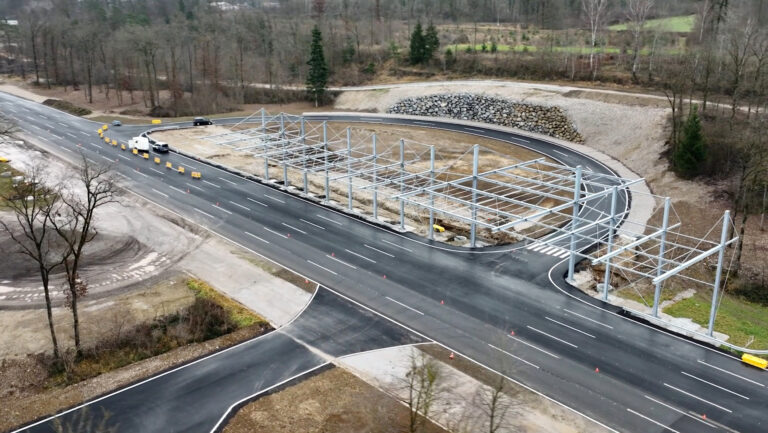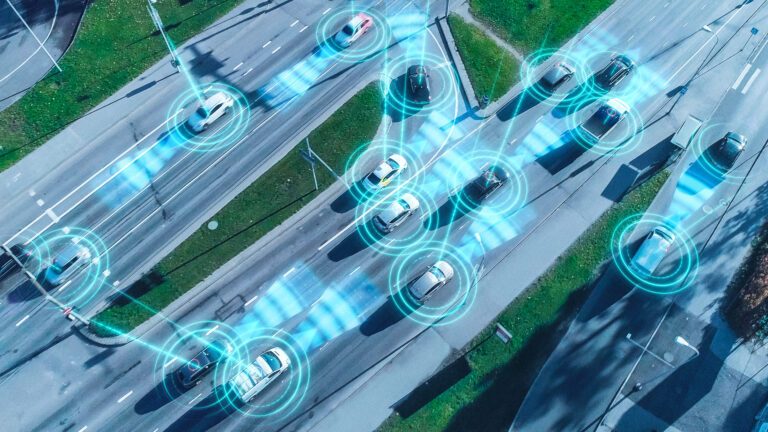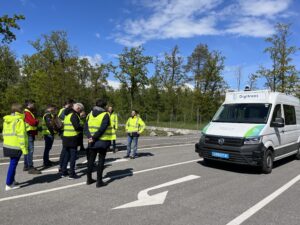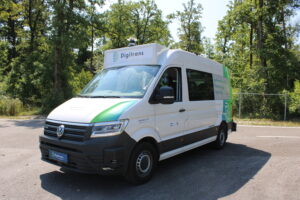First successful ADAS sensor tests with artificially generated rain at the Digitrans Proving Ground for Automated Driving
The Institute of Automotive Engineering at Graz University of Technology, together with KS Engineering, Magna Steyr, the Institute of Vehicle Safety at Graz University of Technology and IPG Automotive, conducted rain tests with ADAS sensors in artificially reproduced rain for the first time in St. Valentin at the Digitrans Proving Ground for Automated Driving in around 306 driving tests.
The aim of the test scenarios driven on the proving ground in St. Valentin was to determine the performance of laser-based ground truth referencing and to measure the performance of radar, LiDAR and camera sensor technology in different weather conditions such as rain, both day and night.
In the future, virtual sensor models will be developed and validated in order to make the validation of automated driving functions more realistic in simulation and in test bench trials.
Performed ADAS - sensor tests in the rain
On the outdoor rain plant at the Digitrans Proving Ground for Automated Driving, around 306 “concerted” driving tests were handled as part of the InVADE project. The complex test scenarios were carried out on 3 lanes and with a total of 4 test vehicles simultaneously. The driving tests were handled both during the day and at night with artificial light.
The selection of the driving scenarios was based on covering as many effects of the ADAS sensor technology as possible, which can also trigger malfunctions, such as object separation and lane detection.
In several test scenarios, different “cut-in maneuvers” were performed with multiple vehicles. The detection of the environment as well as moving objects by the ADAS sensors was compared with reference data of the environment and the executed test scenario.
Among other things, the detection of the lane markings by the ADAS sensors as a function of the rain intensity and the quality of the lane markings was also checked during the driving tests.
ADAS sensor tests on the outdoor rain plant at the Digitrans test center for automated driving in St. Valentin: Cut-in maneuvers by day and by night © TU-Graz
Information about the test vehicles used for the ADAS sensor tests
Measurement technology and equipment of the ego test vehicle:
- DEWETRON CAPS (combined RTK-GPS and IMU measurement of the dynamic vehicle conditions and the driven trajectory).
- Ground truth measurement system from Robosense based on a high resolution lidar.
- Various automotive ADAS sensors allowing access to object lists and partially raw data:
– 2 times Continental 3 series (combined long- and short-range radar)
– 2 times Continental 4 series (combined long-range and short-range radar)
– Robosense 16 beam laser scanner
– Mobileye video camera
– Cohda MK-4 Car2Car communication - Data logger with high recording rate from dspace
Aim of the ADAS sensor tests in the rain
The goal of the sensor tests in artificially reproducible rain was on the one hand to find out the performance of laser-based ground truth referencing, but also to measure the performance of radar, lidar and camera sensor technology under different weather conditions and precipitation intensities.
Furthermore, virtual sensor models are to be developed and validated with which the safeguarding of automated driving functions can be made more realistic in simulation and in test bench trials.
Further fields of application of the outdoor sprinkler system
for sensor tests during rain:
- Performance evaluation of environment awareness systems (LiDAR/radar/camera).
- Performance evaluation of lane marking systems
- Data generation for environment sensor models for virtual ADAS tests
- Data generation for benchmarks of environment awareness systems
“The unique setup of the outdoor sprinkler system at the Digitrans Proving Ground in St. Valentin enables systematic and reproducible testing of ADAS sensors in rain under real conditions for the first time.”
Assoc.Prof. Dipl.-Ing. Dr.techn. Arno Eichberger – Institute of Automotive Engineering / Head of the research area Vehicle Dynamics – Graz University of Technology

Experiences and output of the first ADAS sensor tests in the rain:
The outdoor sprinkler system at the Digitrans Test Center for Automated Driving on the proving ground in St. Valentin, Austria has already proven extremely successful in the InVADE project during the first evaluation phase due to the repeatability of the rain tests with exactly the same settings.
- Determination of precise measurement data based on the ADAS sensor tests carried out in the rainThe 306 driving tests (of which 278 were evaluable) conducted at the Digitrans Proving Ground for Automated Driving under different conditions, both day and night at different rain intensities, provide the basis for developing sensor models. The goal of sensor model development at the Institute of Automotive Engineering at the Graz University of Technology (FTG) is phenomenological and data-driven modeling approaches, which is why a large amount of precise measurement data is necessary. These measurement data could now be obtained based on the ADAS tests conducted on the sprinkler system at the Digitrans Proving Ground for Automated Driving in St. Valentin.
- Evaluation of the predictive capability of simulated sensor models as a further stepIn order to prove the quality of the sensor models or to compare them with other approaches, the DGT-SMV method was developed at the Institute of Vehicle Technology at Graz University of Technology – see https://www.mdpi.com/1996-1073/15/7/2545 . This method will be further developed in the course of the project. It is an exact re-simulation of the driven driving tests in the simulation program IPG CarMaker. With a statistical comparison of the measured data of the real and the simulated sensor, the predictive capability of sensor models can be evaluated.
You might also be interested in
Further Insights

Testcenter for automated driving – expansion of the proving ground in St. Valentin
The expansion of the proving ground in St. Valentin marks an important step toward the mobility of the future. A state-of-the-art test infrastructure for automated vehicle technologies is to be created in order to develop, test and verify safe, connected and autonomous driving in Austria.

Digitrans is an official member of the International Alliance for Mobility Testing and Standardization (IAMTS)
Digitrans is an official member of IAMTS and is pleased to support the development of standardized and certified test methods for automated driving.

Automated driving in Upper Austria – change of management at Digitrans
Mr. Alexander Barth will take over the business activities of Digitrans GmbH as successor of Mrs. Tatschl-Unterberger. He was nominated as the new Managing Director for DigiTrans GmbH in a multi-stage selection process by a seven-member jury of the Supervisory Board, in which all shareholders of DigiTrans GmbH are represented.




